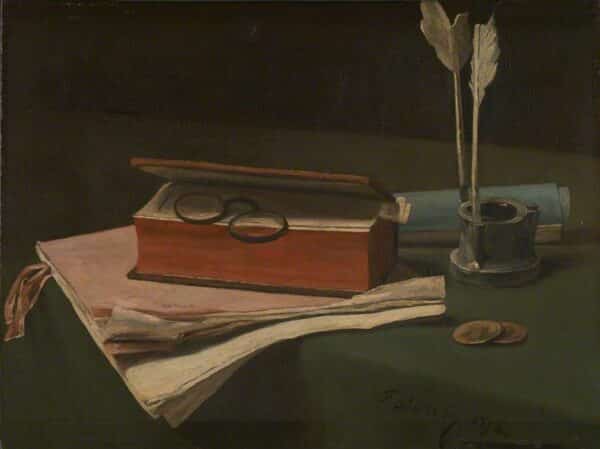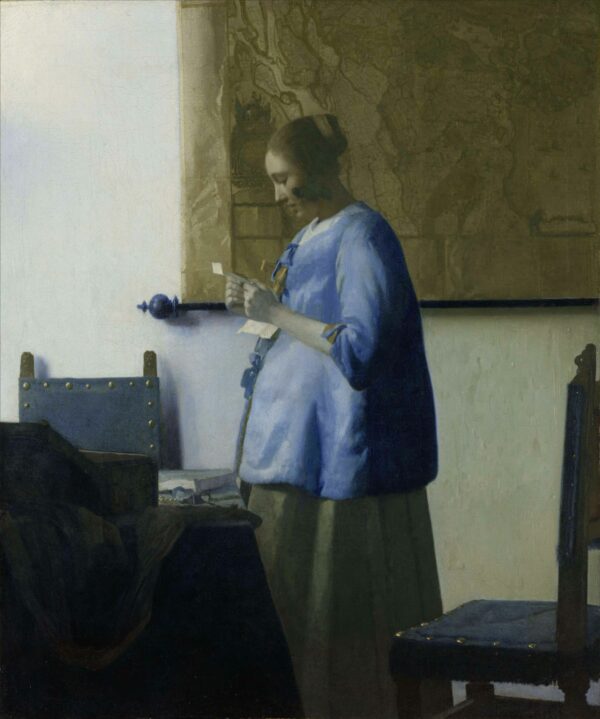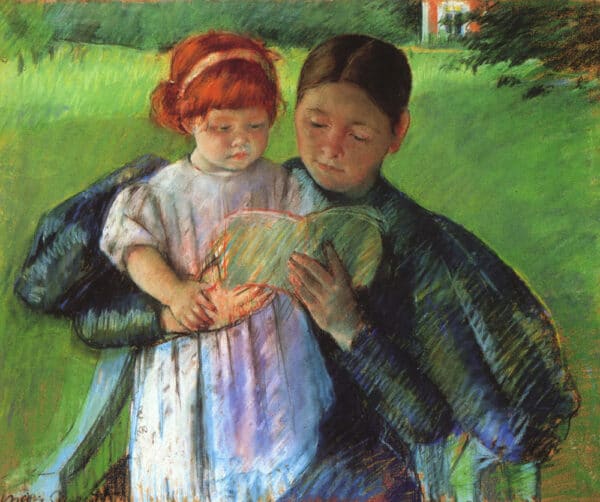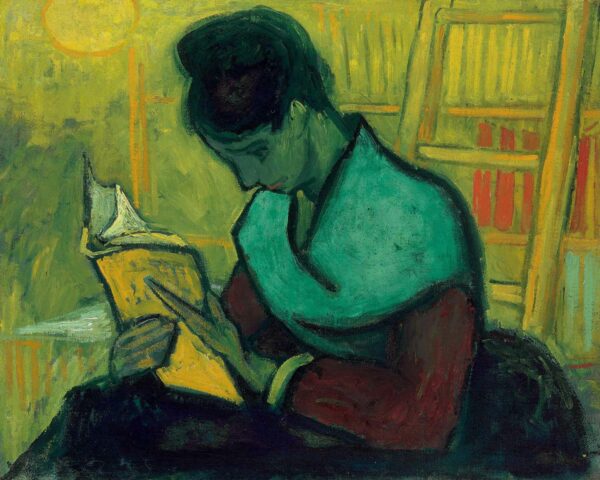Storytelling in Blue and White

Bonvin, Francois; Still Life with Book, Papers and Inkwell; The National Gallery, London
As we enter a brand new year, a time of rejuvenation and fresh starts, we look ahead with joy to the wonderful annual National Storytelling Week that begins in the UK on Saturday 1st of February.
This glorious week of celebration presents us with an opportunity to look at a range of paintings in which we explore human engagement in stories. Through words written and tales told, we are all able to immerse ourselves in alternate realities, learn about the world, meditate, escape, and feel a spectrum of emotions that we may not experience in our own lives, thereby enabling us to connect more to each other.
Artists have long depicted our engagement with the written word, highlighting personal moments of love and loss, of reflection and despair, happiness and discovery; oftentimes employing our favourite tones of blue and white in order to capture certain essences and evocations. Paintings, books (and the stories they tell) remain a vital thread within our human existence.
In alignment with National Storytelling Week, we hope to inspire and encourage you to seek out more stories in both literature and paintings. Besides, who wouldn’t like to be cosied up by the fire with a book at this time of year?!
Johannes Vermeer and the Woman in Blue

Johannes Vermeer, Woman in Blue Reading a Letter, c. 1663, oil on canvas, Rijksmuseum, Amsterdam
Seventeenth century Dutch painter Johannes Vermeer is undeniably one of our best loved artists. Therefore, we thought we’d start with his 1663 oil on canvas Woman in Blue Reading a Letter. Although, in this particular piece, our subject matter isn’t reading a book but a letter instead, the implication that said letter is probably one of love means it is still a perfect representation of the telling of, and reaction to, a story.
In this painting, a woman dressed in blue (her figure suggestive perhaps of pregnancy) stands alone in her toilet reading a letter. The woman’s intense gaze and open mouth indicates an emotional response to the words in front of her. Both hands hold the letter tightly as she reads in profile, completely unaware of the viewer looking in on her solitary state – the intensity of the moment so keenly captured.
The rich blues of the dress, table covering and the upholstered chairs are complemented by the creamy white walls, on which a bluish shadow falls. With these calm and restful tones, combined with the delicate light from an unseen window, Vermeer achieves a moment of total absorption, as the world around our woman in blue fades out and the written word captures her mind and attention entirely.
The pearls strewn on the table appear to have been disregarded, perhaps in exchange for the unexpected arrival of the correspondence. However, Vermeer gives us no certain answer to the question of what exactly is written on that piece of paper? Whilst the scene depicted is one of intimacy and quiet, the questions that are left for the viewer to wonder means we are as enchanted by the painting as the lady is by her letter; held as still as she is, just for a moment.
Mary Cassatt and the Nurse Reading

Mary Cassatt, Nurse Reading to a Little Girl, 1895
Next we have a pastel piece by American painter and printmaker, Mary Cassatt. An artist whose work focused mostly on figure compositions, in her 1895 work Nurse Reading to a Little Girl, Cassatt depicts a scene which epitomises the essence of National Storytelling Week.
This heartwarming piece is one that captures the sweetness and innocence of one generation imparting the joys of storytelling to the next. The nurse holds the little girl closely, as they sit on a bench exploring the pages of what could be a woodland fantasy or tales of a far-off land. The viewer watches as the little girl’s imagination is captured, her gaze attentive and her small hand resting on the nurse’s arm.
The deep blue tones of the nurse’s dress blend into the white and pink hues of the little girl’s frock, her red hair standing out against the greens of their garden setting. With this colour palette the artist evokes a sense of nurture, tranquility and trust between the child and her maternal caregiver, in a space beyond the knowing comfort of a nursery setting.
Cassatt’s admiration of the European avant-garde and artists, such as Degas, is evident in the short, stroked pastel marks; the house and foliage in the background left impressionistic in order to bring the viewer’s focus to the narrative of the foreground. In this work Cassatt gives us a wonderful example of a painting telling the story of a story being told, and a child’s early connection to the storytelling world.
Vincent van Gogh and the Novel Reader in Her Library

Vincent Van Gogh, Une Liseuse de Romans (The Novel Reader), Oil on Canvas, Painted in Arles, November 1888
Finally, with an image that may reflect more closely our current inclinations towards being inside, we have a striking oil on canvas by Vincent Van Gogh. Painted in 1888 and titled Liseuse de Romans (The Novel Reader), in this striking image we see a woman seated in a library, dressed for the period of dreary November weather in which the work was painted. One can easily imagine the warmth of her discarded coat beside her just out of frame.
Through the use of thick line work and bold colours, Van Gogh focuses not on the identity of the reader but more so on the act of reading itself. Van Gogh is renowned for his personal passion for books and, in this work, the woman’s facial expression conveys the emotional intensity of her engagement in its pages.
The flat planes of colour and the boldness of the yellow book and vivid shawl emphasise this message, whilst the figure’s solitude is reinforced by the blue hues of her skin and darkness of her skirt against the brighter background behind her.
By depicting the figure not only immersed in her novel, but also surrounded by books, Van Gogh presents to the viewer the passion and intensity of reading, born no doubt by his strong belief in the importance of reading – how the stories they hold can enhance our lives in so many ways, not least by offering the reader an escape, something that we all need sometimes.
Celebrating Storytelling
We hope that with this wonderful selection of artworks we might have reignited your spark for storytelling! No matter the way in which you engage with stories, be it through books, poems, paintings or letters from afar, we hope you enjoy the moments of imagination and connection that they bring.
If your pleasure of choice happens to be a book, then why not treat yourself or a loved one to one of our wonderful magnetic bookmarks, decorated in beautiful blue and white life drawings? Or, perhaps, if you have your own stories to tell, you might like a delightful Delf Figure pad to jot down your ideas.
From all of us at the Blue & White Company, happy Storytelling Week wherever you are, and here’s to the joy and imagination of shared stories in 2025!
“I have a more or less irresistible passion for books,
and I want to keep devouring them.”
Vincent Van Gogh – Letter to Theo van Gogh, December 4, 1877.